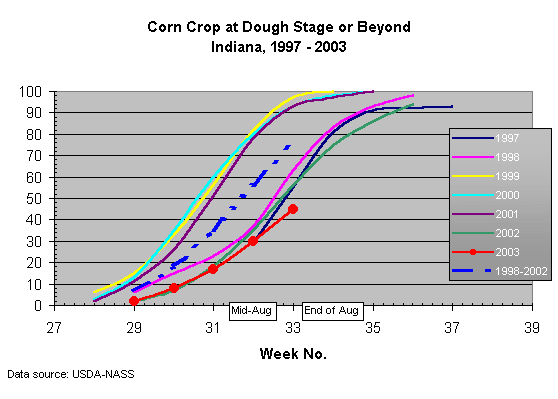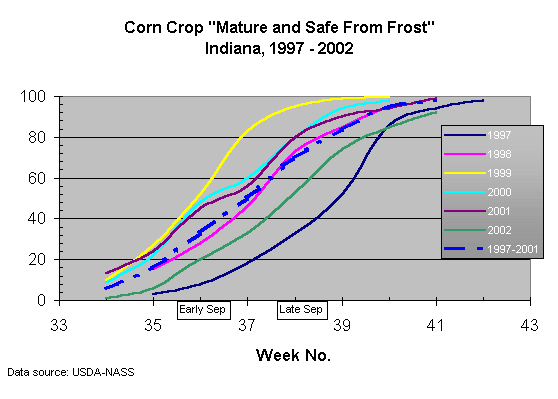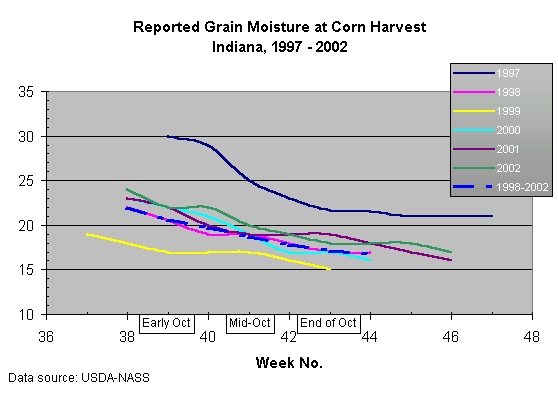

![]() rogress of the 2003 Indiana corn crop continues to lag
behind the average pace of the past five years according to the Indiana
Agricultural Statistics Service (8/18/03). Compared to the period 1998-2002,
the current crop is moving through the dough stage of kernel development
approximately 10 to 14 days behind “schedule”.
rogress of the 2003 Indiana corn crop continues to lag
behind the average pace of the past five years according to the Indiana
Agricultural Statistics Service (8/18/03). Compared to the period 1998-2002,
the current crop is moving through the dough stage of kernel development
approximately 10 to 14 days behind “schedule”.

The slow statewide progress of this year’s corn crop is due to the slow finish of the planting season (especially southern Indiana), the cooler than normal month of May that delayed initial progress of the early planted crop, and generally cooler than normal temperatures throughout the summer that further delayed plant development. The regulars down at the Chat ‘n Chew Café are keenly aware of the slower than desirable crop progress, especially in terms of the potential for wetter grain at harvest and higher grain drying costs this fall.
Corn hybrids generally reach physiological maturity (kernel black layer development) approximately 65 days after silking. The silking-to-maturity period for early to mid-June planted corn is remarkably only a few days longer than for corn planted in late April to early May (Brown, 1999). The reason is that late-planted corn typically matures in significantly fewer heat units than early-planted corn (Nielsen & Thomison, 2003).
The remainder of the season will influence actual maturity date of the crop, but will more greatly influence the rate of grain moisture drydown prior to harvest time. Warmer than normal temperatures through September would help the crop mature more quickly and encourage faster grain drying rates in the field (Nielsen, 2000a). Unusually cool temperatures, on the other hand, would exacerbate the already delayed crop, further delay grain maturity, and slow in-field grain drying rates. Let me illustrate with a few examples from the past five years.
The currently reported percent of crop at dough stage or beyond (45 % as of 8/17/03) is slightly behind that of several other delayed seasons in recent history: 1997, 1998, and 2002. The 1997 season finished unusually cool, further delaying the crop maturity, and resulted in the wettest grain at harvest reported during the five-year period 1997-2002. Last year’s crop (2002) finished slightly wetter than the 1998 crop, but both were significantly drier at harvest than 1997 even though all three season’s crops were at about the same stage of progress in mid-August.

Another interesting statistic is that even though the 1999, 2000, and 2001 crops were all 7 to 10 days AHEAD of normal relative to the timing of the dough grain fill stage, only the 1999 crop finished with harvest grain moistures significantly drier than average.

The bottom line in this discussion is that while we can be fairly certain that grain moistures this fall will not be drier than normal, it is far less certain that they will be dramatically wetter than normal simply because the crop is behind schedule in mid-August. Based on recent history, it is probably fair to say that Indiana growers can expect grain moistures to be 2 to 3 points wetter than average if growing conditions remain fairly normal from here on out. If temperatures for the remainder of August and September take a nosedive, then crop maturity and field drydown will be further delayed. Regardless of whether this year’s grain will be wet or really wet; take the opportunity between now and harvest to check over your grain drying operation (Brook & Maier, 1994; Maier & Bartosik, 2002) to ensure maximum potential drying efficiency this fall.
Remember, as Yogi Berra once said, “It ain't over until it’s over.”